Gerry Adams's Blog, page 35
October 10, 2018
Duke Street - 50 years later
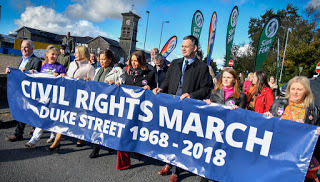
Duke Street – 50 years laterLast Saturday in Derry was a great day. The 50thanniversary of the October 5th 1968 civil rights march was a colourful and optimistic event attended by thousands. I want to commend all of those who helped organise and who participated in it. The mood was upbeat, positive and determined. Where 50 years ago a peaceful demonstration was attacked by the RUC and people left bloodied and scattered, this year Derry resounded to the sound of thousands of voices laughing, singing, happy, confidant. The raised voices of an indomitable people singing ‘We shall overcome’ echoed around the Guild Hall.50 years ago the Stormont regime’s uncompromising response to the civil rights campaign saw the then Ulster Unionist Home Affairs Minister Bill Craig ban the march. Craig went on to form the ultra-right wing Ulster Vanguard Movement. During one speech several years later he spoke about the need to “build dossiers on the men and women who are a menace to this country, because one day, ladies and gentlemen, if the politicians fail, it may be our job to liquidate the enemy.”
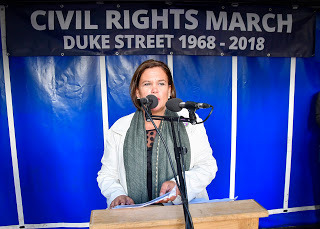 Last weekend Derry marked the Duke Street anniversary with a series of events. It was an occasion to reflect on the courage and vision of those who, participated in a march that was to become a pivotal moment in our recent history and which for some marks the beginning of what has been described as ‘the Troubles’. The RUC’s violent assault on the civil rights demonstrators resulted in street fighting in different parts of Derry City and witnessed the first barricades of the conflict erected in the Bogside. Ten days later the nationalist representatives withdrew as the official opposition in the Stormont Parliament, and more civil rights marches were held and banned. A month later the Unionist regime, led by Terence O’Neill, announced a series of reforms. These included Councils being
encouraged
to use a points system for allocating homes, the company vote – whereby business people had a vote for each building they owned - was to be abolished and the government would
consider
suspending parts of the Special Powers Act.
Last weekend Derry marked the Duke Street anniversary with a series of events. It was an occasion to reflect on the courage and vision of those who, participated in a march that was to become a pivotal moment in our recent history and which for some marks the beginning of what has been described as ‘the Troubles’. The RUC’s violent assault on the civil rights demonstrators resulted in street fighting in different parts of Derry City and witnessed the first barricades of the conflict erected in the Bogside. Ten days later the nationalist representatives withdrew as the official opposition in the Stormont Parliament, and more civil rights marches were held and banned. A month later the Unionist regime, led by Terence O’Neill, announced a series of reforms. These included Councils being
encouraged
to use a points system for allocating homes, the company vote – whereby business people had a vote for each building they owned - was to be abolished and the government would
consider
suspending parts of the Special Powers Act.
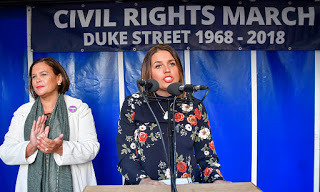
It was an inadequate response to the crisis that was building. There was no acceptance of the right of every person to vote in local elections; no commitment to end the gerrymandering of electoral boundaries; no obligation to end discrimination in employment or in housing; and no commitment to end the Special Powers Act or disband the B Specials.The refusal of the Unionist government to introduce basic rights for all citizens, and the failure of the British and Irish governments to take decisive action against the sectarian policies of the Stormont regime, set the context for the decades of instability and conflict that followed.50 years later much of society in the North has been transformed. The Orange State is gone. In the last Assembly election unionists lost their majority. But the sectarian philosophy that dominated the northern state under unionism can still be found in the desire of some to deny equality to Irish language speakers and reproductive rights for women. Marriage equality now exists in all parts of these islands except the north because the DUP oppose it. And the legacy proposals that emerged out of the Stormont House Agreement have been blocked by the DUP/British government alliance.
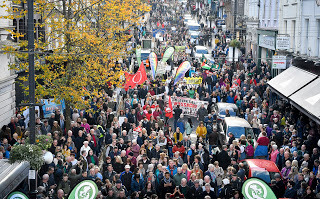 Regrettably, elements of the media chose to ignore the weekend march just as they had ignored the civil rights march 50 years ago. Watching the local BBC news it was as if no march had occurred. The Belfast Telegraph even went so far as to speak of the “perceived injustices against Catholics” at that time. A minority of voices chose to criticise Sinn Féin for organising the demonstration. Their claim was that as Sinn Féin was not part of the 1968 demonstration we couldn’t commemorate the event. Indeed some have tried to erase the role of republicans entirely from the story of the civil rights campaign.
Regrettably, elements of the media chose to ignore the weekend march just as they had ignored the civil rights march 50 years ago. Watching the local BBC news it was as if no march had occurred. The Belfast Telegraph even went so far as to speak of the “perceived injustices against Catholics” at that time. A minority of voices chose to criticise Sinn Féin for organising the demonstration. Their claim was that as Sinn Féin was not part of the 1968 demonstration we couldn’t commemorate the event. Indeed some have tried to erase the role of republicans entirely from the story of the civil rights campaign.
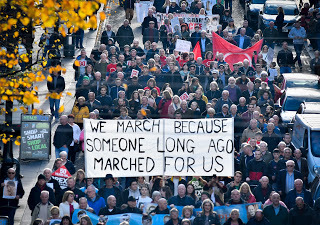 The truth, of course, is that many republicans helped to organise, steward and participate in most of the events planned by the Civil Rights Association at that time. We were part of that narrative and that initiative. Sinn Féin was a banned organisation but through the Wolfe Tone Societies, the Republican Clubs, the Belfast and Derry Housing Action Committees, the Civil Rights Association and as individuals Republican activists played our part in campaigning for civil rights. Many others played their part too. Among them Eamonn McCann, Paddy Kennedy and Bernadette McAlliskey and others like Gerry Fitt, Ivan Cooper and John Hume who would later form the SDLP.In 1967-68 hundreds of people came together in Derry to take a stand against inequality and injustice in a sectarian, one party dominated state that did not respect or want them. They refused to give their consent to this. They refused to consent to being treated as second class. They demanded equality. The thousands who marched last Saturday were acknowledging the vision and courage of those who marched that route 50 years ago. But they were also taking a stand against inequality and injustice today and demonstrating their determination to complete that journey.
The truth, of course, is that many republicans helped to organise, steward and participate in most of the events planned by the Civil Rights Association at that time. We were part of that narrative and that initiative. Sinn Féin was a banned organisation but through the Wolfe Tone Societies, the Republican Clubs, the Belfast and Derry Housing Action Committees, the Civil Rights Association and as individuals Republican activists played our part in campaigning for civil rights. Many others played their part too. Among them Eamonn McCann, Paddy Kennedy and Bernadette McAlliskey and others like Gerry Fitt, Ivan Cooper and John Hume who would later form the SDLP.In 1967-68 hundreds of people came together in Derry to take a stand against inequality and injustice in a sectarian, one party dominated state that did not respect or want them. They refused to give their consent to this. They refused to consent to being treated as second class. They demanded equality. The thousands who marched last Saturday were acknowledging the vision and courage of those who marched that route 50 years ago. But they were also taking a stand against inequality and injustice today and demonstrating their determination to complete that journey.
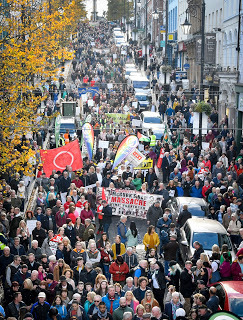
Published on October 10, 2018 09:08
October 4, 2018
Tish Holland – a practical patriot.
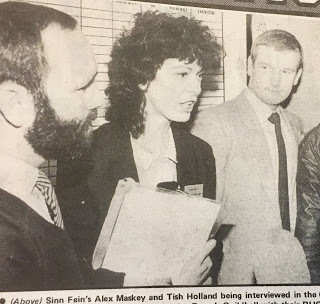 Tish and Alex just elected in 1985 to Belfast City Council - Brian Quinn looks on
Tish and Alex just elected in 1985 to Belfast City Council - Brian Quinn looks on
Teresa Holland – Lunney – died last week. Better known as Tish she was the youngest woman ever interned by the British in the 1970s. She was aged 17 when arrested in February 1973 and imprisoned in Armagh prison without charge or trial. Tish was also the longest serving woman internee.
She was a strong woman - a bright, intelligent, immensely able woman. She knew she was dying. She faced up to that challenge with the same courage and grace that marked her life as a republican and community activist.
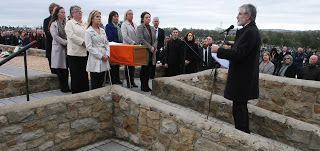 Saying Good-bye to Tish
I visited Tish the Sunday before she died. Despite the pain and knowing how ill she was, Tish was still Tish. She was calm. Relaxed. In the last weeks of her life Tish’s thoughts were for others. There was a positivity about her approach to death. Along with her husband Phil and her good friend and close comrade Alex Maskey she planned her funeral. That’s why I gave the oration. I was under orders from Tish.Positivity was Tish’s essential philosophy of life. The hippy in her had little time for negativity. She wanted her wake and funeral to be a celebration of her life. No long faces. Phil was the love of Tish’s life. They were married for 29 years. Phil demonstrated great courage and resilience as he came to terms with Tish’s Tomás and Nuala are the shining lights of Phil and Tish’s love. They are a credit to their parents and Tish loved and cherished them both.
Saying Good-bye to Tish
I visited Tish the Sunday before she died. Despite the pain and knowing how ill she was, Tish was still Tish. She was calm. Relaxed. In the last weeks of her life Tish’s thoughts were for others. There was a positivity about her approach to death. Along with her husband Phil and her good friend and close comrade Alex Maskey she planned her funeral. That’s why I gave the oration. I was under orders from Tish.Positivity was Tish’s essential philosophy of life. The hippy in her had little time for negativity. She wanted her wake and funeral to be a celebration of her life. No long faces. Phil was the love of Tish’s life. They were married for 29 years. Phil demonstrated great courage and resilience as he came to terms with Tish’s Tomás and Nuala are the shining lights of Phil and Tish’s love. They are a credit to their parents and Tish loved and cherished them both.
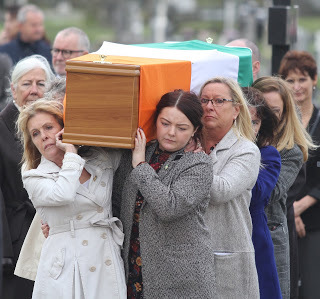 Tish’s politics were shaped by the world about her, by her family, her community, her class, her gender and her life experience. She was very conscious of discrimination and injustice. She was politicised by the events of 1969, the battle of the Bogside, and the pogroms of that August. She was inspired by the actions of Maire Drumm, Marie Moore and the hundreds of women who broke the Falls Curfew in 1970. And she was angered and outraged by the actions of the RUC and British Army.Tish’s response was to join the IRA. They were difficult and dangerous times. In July 1972 the British launched Operation Motorman. It was the violent occupation of nationalist communities using thousands of soldiers. Tish went on the run. On 29 December 1972 Liz McKee - a close friend and comrade to Tish – was arrested and imprisoned in Armagh prison. Liz was the first women internee. Tish was the second. Within weeks Liz and Tish and three others made a bid for freedom.
Tish’s politics were shaped by the world about her, by her family, her community, her class, her gender and her life experience. She was very conscious of discrimination and injustice. She was politicised by the events of 1969, the battle of the Bogside, and the pogroms of that August. She was inspired by the actions of Maire Drumm, Marie Moore and the hundreds of women who broke the Falls Curfew in 1970. And she was angered and outraged by the actions of the RUC and British Army.Tish’s response was to join the IRA. They were difficult and dangerous times. In July 1972 the British launched Operation Motorman. It was the violent occupation of nationalist communities using thousands of soldiers. Tish went on the run. On 29 December 1972 Liz McKee - a close friend and comrade to Tish – was arrested and imprisoned in Armagh prison. Liz was the first women internee. Tish was the second. Within weeks Liz and Tish and three others made a bid for freedom.
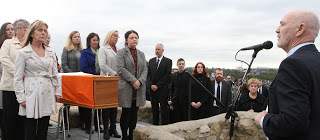 In an article in the IRIS magazine in August 1984 Tish recalled the events. She said: “Liz McKee and I were in one cell, three remand POWs were in the next – Cathy Robinson, Marie Maguire and Evelyn Brady. We got hacksaws in our parcels and started on the bars. We also made ropes out of brown nylon wool. We had three cell searches that week. On Sunday night, about midnight, we finished the bars and came out.”But the alarm was raised by a prison officer who had noticed that there was a bar missing in Tish’s cell window. The five were caught and ended up on the boards. Tish and her comrades were undaunted.In October 1974 Republican POWs in Long Kesh burned the camp to the ground. Hand to hand fighting took place between the POWs and British soldiers. Scores of prisoners were injured, some seriously. The morning after the women in Armagh took the prison governor and two of his staff hostage. They demanded confirmation that their injured comrades in Long Kesh had access to proper medical treatment. That evening the prison chaplain, Fr. Raymond Murray, assured the women that the prisoners in Long Kesh were receiving medical treatment, including treatment at hospitals in Belfast for the most seriously injured. The governor was released and the women returned to their cells.
In an article in the IRIS magazine in August 1984 Tish recalled the events. She said: “Liz McKee and I were in one cell, three remand POWs were in the next – Cathy Robinson, Marie Maguire and Evelyn Brady. We got hacksaws in our parcels and started on the bars. We also made ropes out of brown nylon wool. We had three cell searches that week. On Sunday night, about midnight, we finished the bars and came out.”But the alarm was raised by a prison officer who had noticed that there was a bar missing in Tish’s cell window. The five were caught and ended up on the boards. Tish and her comrades were undaunted.In October 1974 Republican POWs in Long Kesh burned the camp to the ground. Hand to hand fighting took place between the POWs and British soldiers. Scores of prisoners were injured, some seriously. The morning after the women in Armagh took the prison governor and two of his staff hostage. They demanded confirmation that their injured comrades in Long Kesh had access to proper medical treatment. That evening the prison chaplain, Fr. Raymond Murray, assured the women that the prisoners in Long Kesh were receiving medical treatment, including treatment at hospitals in Belfast for the most seriously injured. The governor was released and the women returned to their cells.
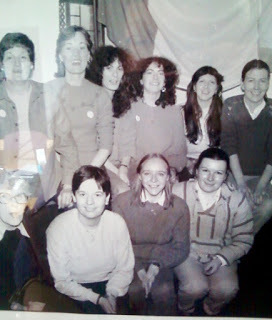 The Belfast Women's Dept of Sinn Féin 1979
After her release from Armagh prison in the summer of 1975 Tish emerged as a first class Sinn Féin activist. In 1979 she was one of those who established the party’s first Women’s Department in Belfast. During the Fermanagh South Tyrone by-election campaign for Bobby Sands in April and May 1981 Tish worked in the Dungannon office. Later she spent time in Leitrim working in the campaign for Joe McDonnell.In the Assembly elections of 1982 Tish was our Director of Canvas for the west of the City. She predicted that in west Belfast Sinn Féin would take around 10,000 votes. When the votes were counted Alex and I had 10,367 votes. It was a remarkable result in a first time election by Sinn Fein. It was an equally impressive prediction by our first time Director of Canvas.In 1985 Tish was one of seven Sinn Féin Councillors who won seats in Belfast – Alex, Sean, Bobby Lavery, Lilly Fitzsimons, Sean Keenan, Gerard McGuigan and Tish. It was a stunning victory for Sinn Féin.
The Belfast Women's Dept of Sinn Féin 1979
After her release from Armagh prison in the summer of 1975 Tish emerged as a first class Sinn Féin activist. In 1979 she was one of those who established the party’s first Women’s Department in Belfast. During the Fermanagh South Tyrone by-election campaign for Bobby Sands in April and May 1981 Tish worked in the Dungannon office. Later she spent time in Leitrim working in the campaign for Joe McDonnell.In the Assembly elections of 1982 Tish was our Director of Canvas for the west of the City. She predicted that in west Belfast Sinn Féin would take around 10,000 votes. When the votes were counted Alex and I had 10,367 votes. It was a remarkable result in a first time election by Sinn Fein. It was an equally impressive prediction by our first time Director of Canvas.In 1985 Tish was one of seven Sinn Féin Councillors who won seats in Belfast – Alex, Sean, Bobby Lavery, Lilly Fitzsimons, Sean Keenan, Gerard McGuigan and Tish. It was a stunning victory for Sinn Féin.
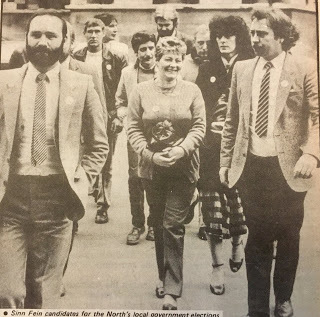 The Belfast Sinn Féin team 1985
It sparked a vicious campaign by unionist Councillors to deny Sinn Fein representatives any real say in the running of the council. Tish and her six comrades ran a daily gauntlet of physical and verbal threats and abuse. They were denied speaking rights in the Chamber. They were shouted down. Deodorant and other sprays were used against them.It was a dangerous time for Sinn Féin members. During the eight years Tish was a Councillor three Sinn Féin Councillors were shot dead; John Davey, Eddie Fullerton and Bernard O’Hagan. 14 party members were killed in that period. Family homes and offices were attacked, including the party room in the City Hall.After two terms in the Council Tish decided not to stand again in order to concentrate her considerable energy and talents on community work. Tish loved west Belfast. She loved its people. She especially loved upper Andytown and Lenadoon. Tish used her skills in networking and campaigning to persuade others to invest in Upper Andersonstown. She was a very practical patriot. As a result, the Tullymore Community Centre was opened in 2000. In 2000 they won the Aisling Award for Community Endeavour and again in 2012, and in 2013 the All Ireland Pride of Place Community Award. Tish was an unapologetic united Irelander. She was a leader - a team player and a team builder. She was a woman of compassion – who believed in equality and in citizens’ rights. She loved her family and she loved her country.Tish’s loss will be felt most by her family. By Phil, Nuala, Tomás and all her brothers and sisters. But I hope they take strength too from the fact that there are so many others grieving with them.
The Belfast Sinn Féin team 1985
It sparked a vicious campaign by unionist Councillors to deny Sinn Fein representatives any real say in the running of the council. Tish and her six comrades ran a daily gauntlet of physical and verbal threats and abuse. They were denied speaking rights in the Chamber. They were shouted down. Deodorant and other sprays were used against them.It was a dangerous time for Sinn Féin members. During the eight years Tish was a Councillor three Sinn Féin Councillors were shot dead; John Davey, Eddie Fullerton and Bernard O’Hagan. 14 party members were killed in that period. Family homes and offices were attacked, including the party room in the City Hall.After two terms in the Council Tish decided not to stand again in order to concentrate her considerable energy and talents on community work. Tish loved west Belfast. She loved its people. She especially loved upper Andytown and Lenadoon. Tish used her skills in networking and campaigning to persuade others to invest in Upper Andersonstown. She was a very practical patriot. As a result, the Tullymore Community Centre was opened in 2000. In 2000 they won the Aisling Award for Community Endeavour and again in 2012, and in 2013 the All Ireland Pride of Place Community Award. Tish was an unapologetic united Irelander. She was a leader - a team player and a team builder. She was a woman of compassion – who believed in equality and in citizens’ rights. She loved her family and she loved her country.Tish’s loss will be felt most by her family. By Phil, Nuala, Tomás and all her brothers and sisters. But I hope they take strength too from the fact that there are so many others grieving with them.
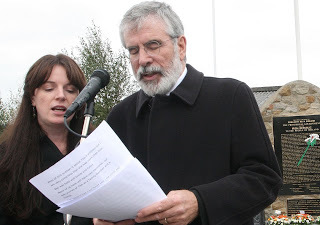 Mise agus Grainne Holland sing Four Green Fields
I heard a great version of Four Green Fields recently. It had a new chorus. A kick in the arse for the patriarchy. And a huge hurrah for the matriarchy. It was made for Tish and our wonderful republican women.“What have a now said the fine old womanWhat have a now this fine old woman did sayI have four green fieldsOne of them’s in bondageIn strangers’s hands that tried to take it from meBut my daughters will have daughters,As brave as were their mothersAnd my four green fields will bloom once again said she.”
Mise agus Grainne Holland sing Four Green Fields
I heard a great version of Four Green Fields recently. It had a new chorus. A kick in the arse for the patriarchy. And a huge hurrah for the matriarchy. It was made for Tish and our wonderful republican women.“What have a now said the fine old womanWhat have a now this fine old woman did sayI have four green fieldsOne of them’s in bondageIn strangers’s hands that tried to take it from meBut my daughters will have daughters,As brave as were their mothersAnd my four green fields will bloom once again said she.”
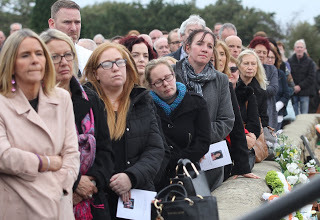
Published on October 04, 2018 03:32
September 29, 2018
Frederick Douglass and Ireland
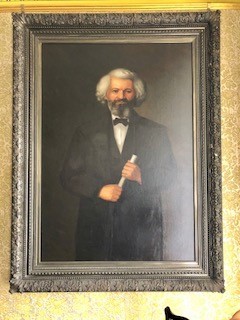 Frederick Douglass
Last week I attended the launch of Christine Kinealy’s authoritative and revealing two volumes on the life and times of Frederick Douglass, 'Frederick Douglass and Ireland: In his own words.' Douglass was born into slavery two hundred years ago this year in the United States. He escaped from slavery, wrote about his experiences and lectured widely, including here in Ireland. Christine Kinealy is the Director of Ireland’s Great Hunger Institute at Quinnipiac University in Connecticut and has had a long association with Ireland writing on Daniel O’Connell, the Great Hunger and, of course Frederick Douglass. Quinnipiac’s Múseam An Ghorta Mór – Ireland’s Great hunger Museum, is a unique collection of art and research and resource materials on that period of Irish history.Christine’s newest book is drawn from over fifty speeches which Douglass gave in Ireland. They are a reminder of the evil and horror that was and is slavery and of the work of the anti-slavery movement that was active in Ireland in the 1840’s. Slavery had been opposed by radical Presbyterian’s in Belfast in the late 18thcentury, many of whom became United Irelanders. Efforts to form a slave company in the city were thwarted and decades later when Douglass lectured in Belfast one of his most enthusiastic supporters was Mary Anne McCracken, sister of the executed leader of 1798. When Douglass left Belfast in January 1846 he left behind a Ladies Anti-Slavery Society one of whose founding members was Mary Anne McCracken.
Frederick Douglass
Last week I attended the launch of Christine Kinealy’s authoritative and revealing two volumes on the life and times of Frederick Douglass, 'Frederick Douglass and Ireland: In his own words.' Douglass was born into slavery two hundred years ago this year in the United States. He escaped from slavery, wrote about his experiences and lectured widely, including here in Ireland. Christine Kinealy is the Director of Ireland’s Great Hunger Institute at Quinnipiac University in Connecticut and has had a long association with Ireland writing on Daniel O’Connell, the Great Hunger and, of course Frederick Douglass. Quinnipiac’s Múseam An Ghorta Mór – Ireland’s Great hunger Museum, is a unique collection of art and research and resource materials on that period of Irish history.Christine’s newest book is drawn from over fifty speeches which Douglass gave in Ireland. They are a reminder of the evil and horror that was and is slavery and of the work of the anti-slavery movement that was active in Ireland in the 1840’s. Slavery had been opposed by radical Presbyterian’s in Belfast in the late 18thcentury, many of whom became United Irelanders. Efforts to form a slave company in the city were thwarted and decades later when Douglass lectured in Belfast one of his most enthusiastic supporters was Mary Anne McCracken, sister of the executed leader of 1798. When Douglass left Belfast in January 1846 he left behind a Ladies Anti-Slavery Society one of whose founding members was Mary Anne McCracken. 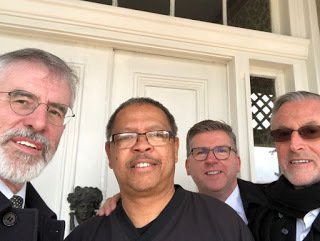 Visiting Douglass home: ltoR: Mise, Phil Gutrich LiUNA, Todd Allen and Joseph Smith FoSF.
Visiting Douglass home: ltoR: Mise, Phil Gutrich LiUNA, Todd Allen and Joseph Smith FoSF.Slavery is not the past. It is the present. It is estimated that between 20 and 40 million people across the world are in slavery. Some are women forced into prostitution, or children working in sweatshops, or men and women forced to work through fear, and threats. Modern slavery takes different forms. Human trafficking, debt bondage, child slavery. There are an estimated ten million child slaves. Think about that – 10 million children living in slavery.For many people in Ireland slavery is something that existed decades, even centuries ago. In the worst years of poverty and landlordism it was endemic on this island. The English landlord class and its agents cruelly exploited this situation to maximise their profits. Here is how one English writer Arthur English – A Tour in Ireland 1780 described conditions at the time: “A landlord in Ireland can scarcely invest an order which a servant, labourer or cotter dares to refuse to execute. Nothing satisfies him but an unlimited submission. Disrespect or anything tending towards sauciness he may punish with his cane or his horsewhip with the most perfect security, a poor man would have his bones broke if he offered to lift a hand in his own defence… Landlords of consequence have assured me, that many of their cottars would think themselves honoured by having their wives or daughters sent for to the bed of their master; a mark of slavery that proves the oppression under which such people must live.” But later slavery took on different forms. It took the shape of the Magdalene Laundries, of mother and baby homes and of the industrial schools. Today slavery still exists globally and there is an obligation on all of us to speak out against it. The story of Douglass is a story of connections with Ireland. At the age of 12 he was encouraged by two Irishmen working in the shipyard where he was a slave labourer, to escape. He made several efforts and eventually escaped at the age of 20.As an escaped slave Frederick Douglass was still liable to be taken by pro-slaver supporters and returned to his former Master. He was reluctant to speak publicly. Eventually however he agreed to speak on the issue and emerged as an articulate and gifted orator. His speeches and lectures were very effective in building support for the anti-slavery movement. In 1845 he published his autobiography, ‘The Narrative of the Life of Frederick Douglass, An American Slave’. Within a few months he had sold over five thousand copies but this success increased the possibility of pro-slave elements capturing him and returning him to slavery.Douglass sailed for Britain in August 1845. On his journey he was asked by the Captain if he would speak to the passengers about his experience. Some pro-slavery passengers threatened to throw Douglass overboard but an unidentified Irishman intervened and threatened to do it to them first.Shortly after he arrived in Liverpool Douglass sailed to Dublin where on 3 September he gave his first lecture in Ireland. Over the following months he travelled to Wexford, Waterford, Cork, Limerick and Belfast. He returned to Belfast another four times.Ireland was in his own word “transformative” for Douglass. In a letter to a friend in Boston he wrote: “I live a new life. The warm and generous co-operation extended to me by the friends of my despised race … and the entire absence of everything that looked like prejudice against me, on account of the colour of my skin – contrasted so strongly with my long and bitter experience in the United States, that I look with wonder and amazement on the transition.”Douglass said of his time in Ireland that he had become a man, rather than a chattel. In the course of his time here he met Daniel O’Connell and others campaigning to end the Union with Britain. He witnessed the awful conditions endured by Irish peasants. Consequently, Douglass increasingly saw the issue of slavery not in isolation but as part of a wider campaign for equality and social justice. He wrote: “I see much here to remind me of my former condition, and I confess I should be ashamed to lift up my voice against American slavery, but that I know the cause of humanity is one the world over. He who really and truly feels for the American slave, cannot steel his heart to the woes of others; and he who thinks himself an abolitionist, yet cannot enter into the wrongs of others, has yet to find a true foundation for his anti-slavery.” In 1848 he was one of the few men to attend the Seneca Falls Convention, the first women’s rights conference. When a dispute arose over whether they should campaign for women to have the right to vote Douglass, who was the only African American participant, successfully argued for its inclusion in the closing Declaration of Sentiments and Resolutions. In a speech in 1867, Douglass said: "Let no man be kept from the ballot box because of his color. Let no woman be kept from the ballot box because of her sex".Douglass’s close association with Belfast should be a matter of great public pride. It is a part of our history that needs to be told and retold. It is also a reminder that the evil of slavery still has to be ended.Frederick Douglass and Ireland: In his own words by Christine Kinealy.This is an expensive two volume publication so if need be order it from your local library.
Published on September 29, 2018 02:15
September 20, 2018
The McGuinness Principles
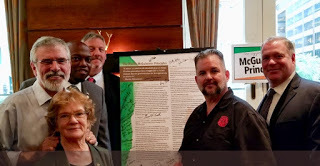 Mise agus Rita with John Samuelson and other Trade Union leaders
Last Friday the Irish American James Connolly Labor Coalition (in the USA Labour is spelt without the u) organised a luncheon meeting of trade union leaders in Manhattan, mainly from New York, to introduce them to and seek their endorsement of the McGuinness Principles. There was a good crowd, good food and good craic. Additional tables were rolled out as more and more trade union delegations arrived. By the time John Samuelson, the International President of the Transport and General Workers Union called the meeting to order the room was packed. John said a few words of introduction and I spoke about the many connections between Ireland and the USA, the McGuinness Principles, and Sinn Féin’s campaign for a unity referendum and a united Ireland. Irish American Labor leaders played a positive role in the political momentum in the USA and in supporting the peace process. Many of the great trade union leaders in American history have their family roots in Ireland. Leaders like Mary ‘Mother’ Jones and Peter Maguire; Mathew Maguire and Mike Quill and many others. That tradition has been carried on to this generation. Leaders like Terry O’Sullivan, the General President of LiUNA, (the Laborers International Union of North America), John Samuelson TWU International President, Jim Callahan President of the International Union of Operating Engineers, and Mary Kay Henry International President of the Service Employees International Union are all proud Irish American labour leaders. Joe Jameson was one of the Irish Americans for a new Irish agenda in the 1990s.These same leaders are enormously proud also of their connection with James Connolly and have contributed to keeping alive his spirit and legacy. Currently in Belfast they are supporting the new Áras Uí Chonghaile – the James Connolly Interpretative Centre – which will be at the junction of the Falls Road and St. James Park close to where James Connolly and his family lived. Connolly was a hugely influential trade union activist in America. He lived in the USA for seven years where he helped establish the ‘Independent Workers of the World’. Connolly understood the importance of workers standing together, united against injustice and oppression. In Belfast he organised the workers of Belfast, and especially the linen slaves - those thousands of young women who worked in hellish conditions in the Mills - which were the backbone of Belfast’s economy. During the Great Lockout of 1913, in the city of Dublin, he and Big Jim Larkin, led an epic struggle for worker’s rights. Larkin too spent time in the USA between 1913 and 1924. This involved three years in various New York prisons, including the notorious Sing Sing, after he was convicted of ‘criminal anarchy’ for fighting for workers’ rights.
Mise agus Rita with John Samuelson and other Trade Union leaders
Last Friday the Irish American James Connolly Labor Coalition (in the USA Labour is spelt without the u) organised a luncheon meeting of trade union leaders in Manhattan, mainly from New York, to introduce them to and seek their endorsement of the McGuinness Principles. There was a good crowd, good food and good craic. Additional tables were rolled out as more and more trade union delegations arrived. By the time John Samuelson, the International President of the Transport and General Workers Union called the meeting to order the room was packed. John said a few words of introduction and I spoke about the many connections between Ireland and the USA, the McGuinness Principles, and Sinn Féin’s campaign for a unity referendum and a united Ireland. Irish American Labor leaders played a positive role in the political momentum in the USA and in supporting the peace process. Many of the great trade union leaders in American history have their family roots in Ireland. Leaders like Mary ‘Mother’ Jones and Peter Maguire; Mathew Maguire and Mike Quill and many others. That tradition has been carried on to this generation. Leaders like Terry O’Sullivan, the General President of LiUNA, (the Laborers International Union of North America), John Samuelson TWU International President, Jim Callahan President of the International Union of Operating Engineers, and Mary Kay Henry International President of the Service Employees International Union are all proud Irish American labour leaders. Joe Jameson was one of the Irish Americans for a new Irish agenda in the 1990s.These same leaders are enormously proud also of their connection with James Connolly and have contributed to keeping alive his spirit and legacy. Currently in Belfast they are supporting the new Áras Uí Chonghaile – the James Connolly Interpretative Centre – which will be at the junction of the Falls Road and St. James Park close to where James Connolly and his family lived. Connolly was a hugely influential trade union activist in America. He lived in the USA for seven years where he helped establish the ‘Independent Workers of the World’. Connolly understood the importance of workers standing together, united against injustice and oppression. In Belfast he organised the workers of Belfast, and especially the linen slaves - those thousands of young women who worked in hellish conditions in the Mills - which were the backbone of Belfast’s economy. During the Great Lockout of 1913, in the city of Dublin, he and Big Jim Larkin, led an epic struggle for worker’s rights. Larkin too spent time in the USA between 1913 and 1924. This involved three years in various New York prisons, including the notorious Sing Sing, after he was convicted of ‘criminal anarchy’ for fighting for workers’ rights.
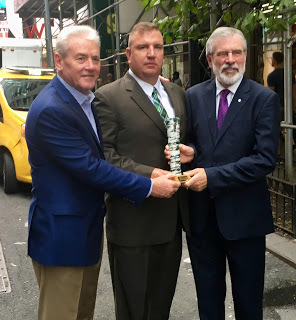 Terry O’Sullivan, General President of LiUNA, (the Laborers International Union of North America), mise agus Jim Callahan President of the International Union of Operating Engineers
Irish American union leaders understand intellectually and emotionally that the cause of Ireland is the cause of Labour and that the cause of Labour is the cause of Ireland. When the talking at the luncheon was over there was an enthusiastic response as they lined up to sign the McGuinness Principles sitting on a stand to the side of the podium. Many of these leaders had met Martin either on his visits to the USA or their visits to Ireland. They admired and respected his efforts to build reconciliation, advance the rights of citizens, and promote peace and Irish unity.The McGuinness Principles reflect Martin’s core values and the Good Friday Agreement. It is an initiative that was launched in April by an alliance of Irish American organisations. The McGuinness Principles were inspired by the Sullivan and MacBride Principles. The Sullivan principles were developed in 1977 and are named after an African-American preacher Rev. Leon Sullivan, who believed that by applying economic conditions on US investment in South Africa that the apartheid regime could be brought to an end. In the 1970’s. The principles called for equal and fair employment practices for all employees and equal pay for all employees doing equal or comparable work for the same period of time. The MacBride Principles based on the Sullivan Principles. They were about challenging institutional discrimination against Catholics in the North’s economy. In 1971 male Catholic unemployment was about two and a half times that of Protestant. Catholic women were twice as likely to be unemployed. Catholics were also pushed into low paid and unskilled employment. Ten years later, and after five years of Britain’s Fair Employment Act, the 1981 figures revealed almost no change. The MacBride Campaign sought to put pressure on US Companies with investments in the North through the enactment of state and municipal laws which would require the companies put the Principles into practice.The nine MacBride Principles, which were named after Nobel Prize winner Sean MacBride, called for the banning of provocative religious and political emblems form the workplace; all job openings to be advertised publicly and special recruitment practices to attract applicants from under-represented religious groups; the establishment of procedures to assess, identify and actively recruit employees with potential for further advancement; managers appointed to oversee a company’s affirmative action efforts and the setting of timetables.The Irish government and the SDLP actively worked with the British government in opposing the MacBride Campaign in the USA.When late last year Irish American organisations began talking about how they could help secure the full implementation of the Good Friday Agreement and support efforts to advance Irish unity, they looked to these previous examples of successful campaigns. As a result, they agreed to launch a campaign around the McGuinness Principles.These four core principles – equality, respect, truth and self-determination - seek to address the current difficulties in the political process by defending human rights, supporting equality for the Irish language, the victims of the conflict and their families, and endorsing the demand for a referendum on Irish unity. In summary the campaign seeks:· A Bill of Rights.· Full statutory equality for the Irish Language.· Funding for legacy inquests as part of the process of healing and reconciliation.· A referendum on Irish unity in keeping with the Good Friday Agreement.In the few months that the campaign has been running it has attracted significant political support. The active endorsement of the Labor Movement in the USA is a crucial addition. If you want to know more about the McGuinness Principles log on to www.mcguinnessprinciples.com
Terry O’Sullivan, General President of LiUNA, (the Laborers International Union of North America), mise agus Jim Callahan President of the International Union of Operating Engineers
Irish American union leaders understand intellectually and emotionally that the cause of Ireland is the cause of Labour and that the cause of Labour is the cause of Ireland. When the talking at the luncheon was over there was an enthusiastic response as they lined up to sign the McGuinness Principles sitting on a stand to the side of the podium. Many of these leaders had met Martin either on his visits to the USA or their visits to Ireland. They admired and respected his efforts to build reconciliation, advance the rights of citizens, and promote peace and Irish unity.The McGuinness Principles reflect Martin’s core values and the Good Friday Agreement. It is an initiative that was launched in April by an alliance of Irish American organisations. The McGuinness Principles were inspired by the Sullivan and MacBride Principles. The Sullivan principles were developed in 1977 and are named after an African-American preacher Rev. Leon Sullivan, who believed that by applying economic conditions on US investment in South Africa that the apartheid regime could be brought to an end. In the 1970’s. The principles called for equal and fair employment practices for all employees and equal pay for all employees doing equal or comparable work for the same period of time. The MacBride Principles based on the Sullivan Principles. They were about challenging institutional discrimination against Catholics in the North’s economy. In 1971 male Catholic unemployment was about two and a half times that of Protestant. Catholic women were twice as likely to be unemployed. Catholics were also pushed into low paid and unskilled employment. Ten years later, and after five years of Britain’s Fair Employment Act, the 1981 figures revealed almost no change. The MacBride Campaign sought to put pressure on US Companies with investments in the North through the enactment of state and municipal laws which would require the companies put the Principles into practice.The nine MacBride Principles, which were named after Nobel Prize winner Sean MacBride, called for the banning of provocative religious and political emblems form the workplace; all job openings to be advertised publicly and special recruitment practices to attract applicants from under-represented religious groups; the establishment of procedures to assess, identify and actively recruit employees with potential for further advancement; managers appointed to oversee a company’s affirmative action efforts and the setting of timetables.The Irish government and the SDLP actively worked with the British government in opposing the MacBride Campaign in the USA.When late last year Irish American organisations began talking about how they could help secure the full implementation of the Good Friday Agreement and support efforts to advance Irish unity, they looked to these previous examples of successful campaigns. As a result, they agreed to launch a campaign around the McGuinness Principles.These four core principles – equality, respect, truth and self-determination - seek to address the current difficulties in the political process by defending human rights, supporting equality for the Irish language, the victims of the conflict and their families, and endorsing the demand for a referendum on Irish unity. In summary the campaign seeks:· A Bill of Rights.· Full statutory equality for the Irish Language.· Funding for legacy inquests as part of the process of healing and reconciliation.· A referendum on Irish unity in keeping with the Good Friday Agreement.In the few months that the campaign has been running it has attracted significant political support. The active endorsement of the Labor Movement in the USA is a crucial addition. If you want to know more about the McGuinness Principles log on to www.mcguinnessprinciples.com
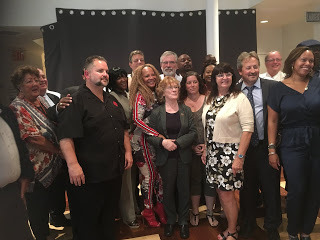
THE MARTIN MCGUINNESS PRINCIPLES“I believe we stand on the threshold of great change. Previous generations have struggled for a United Ireland. But our generation has the best opportunity to achieve it.” -Martin McGuinness(1) EQUALITYTHE ENACTMENT OF A BILL OF RIGHTS:“We have pressed consistently for the establishment of a Bill of Rights in the North and an all-Ireland Charter of Rights” -Martin McGuinnessThe terms of the Good Friday Agreement called for the adoption of a Bill of Rights in the North of Ireland. Twenty years after the Good Friday Agreement was ratified by more than 70% of the voters in the North of Ireland and 94% of the people in the Republic there is still no Bill of Rights. The Northern Ireland Human Rights Commission was mandated to put forward recommendations. In 2008, the Commission made proposals to the UK government recommending the recognition of a broad range of social and economic rights. Successive British governments have failed to affirmatively act on these recommendations. Now, with significant opposition from within the British government to continuing to accept the jurisdiction of European human rights conventions, and a determination to scrap the Human rights Act, it becomes even more important that the rights of Ireland’s citizens in the North be protected when it comes to critical human rights issues.2) RESPECTFULL STATUTORY EQUALITY FOR THE IRISH LANGUAGE:“Successive British Governments…have totally failed to meet their obligations…to protect the rights of the Irish language community” -Martin McGuinnessThe Good Friday Agreement affirmed “the importance of respect, understanding and tolerance in relation to linguistic diversity, including in Northern Ireland, the Irish language, Ulster-Scots and the languages of the various ethnic communities, all of which are part of the cultural wealth of the island of Ireland… the British Government will, in particular in relation to the Irish language, where appropriate and where people so desire it: take resolute action to promote the language; facilitate and encourage the use of the language in speech and writing in public and private life where there is appropriate demand …”Eight years later, under the terms of the St. Andrews Agreement of 2006, the British Government committed to introduce an Act to give the Irish language official status equal to that accorded the Scots Gaelic and Welsh languages. They failed to honor this obligation, and the Democratic Unionist Party explicitly repudiated it. Subsequent DUP moves in government to defund Irish language study were a major contributing factor to the resignation of Martin McGuinness as Northern Ireland’s Deputy First Minister in 2017, when he cited that party’s lack of “respect” for the rights and cultural traditions of the Irish nationalist community in the North.(3) TRUTHEQUAL JUSTICE FOR VICTIMS OF THE CONFLICT AND THEIR FAMILIES:“Dealing with the legacy of the past remains one of the key outstanding challenges of our peace process. Unless it is dealt with in a comprehensive manner then the essential process of healing and reconciliation cannot gain momentum”“Instead of working constructively to address the hurt and pain caused by the legacy of our recent conflict, the British Government has, at every turn, blocked and frustrated all efforts to reach a solution” -Martin McGuinnessMany victims of the conflict in the North and their families have waited decades to learn the full truth about what happened to them and their loved ones. Funding must be provided for proper inquests to move forward. The full story of collusion and cover-ups must be told, and those responsible for human rights abuses must be brought to justice.(4) SELF-DETERMINATIONTHERE MUST BE A REFERENDUM ON IRISH UNITY TO AFFIRM IRISH SELF-DETERMINATION:“There is a democratic imperative to provide Irish citizens with the right to vote in a border poll on Irish unity to end partition and retain a role in the EU.”“A border poll on Irish unity is part of the process of building a modern and dynamic New Republic on this island – an agreed Ireland achieved by peaceful and democratic means.” -Martin McGuinnessUnder the terms of the Good Friday Agreement of 1998, the British Government committed to formally “recognize that it is for the people of Ireland alone, by agreement between the two parts respectively and without external impediment to exercise their right of self-determination on the basis of consent…” Provisions were included for referenda on Irish unity, whose results would be given effect by the governmental parties to the Agreement. The Agreement went on to commit that the signatory parties (including the British Government) should not “make any change in the status of Northern Ireland save with the consent of a majority of its people”.Despite the fact that Brexit clearly represents a “change in status” of Northern Ireland, and despite the fact that the people of the north voted by a large majority to reject Brexit and remain inside the European Union, the British government is determined to impose this very significant change (having potentially profound consequences for Ireland), on the people of Ireland north and south, against their democratically expressed wishes.If the Good Friday Agreement’s commitments to self-determination are to have any meaning, the British Government must allow the Irish people the opportunity to determine their future.
Published on September 20, 2018 03:27
September 14, 2018
Ballymurphy Massacre: The Tip Of The Iceberg.
Last weekend Channel 4 broadcast ‘Massacre at Ballymurphy.’ This is an abridged version of the ‘Ballymurphy Precedent’. It is a documentary film for cinema that examines the circumstances which led to the killing of 11 civilians by the Parachute Regiment in Ballymurphy in the three days after the first internment raids occurred on the morning of 9th August 1971. The survivors and relatives of the victims give their first-hand accounts of the deaths of loved ones. Eleven people - ten men, including a local priest and a mother of eight children - were shot dead. 46 children were left without a parent. Their lives forever changed.It was a story of tragedy and loss, of heroism and leadership. It exposed the lengths to which the British government went to cover up the actions of its troops. The lies they told and the willingness of some in the media to publish unchallenged claims that those killed were gunmen and a gun woman. It was an emotional film in which the relatives spoke calmly, passionately, honestly, about the circumstances that led to, and followed the massacre. For them, even after 47 years, the memories are still raw. They cried. Some clearly had difficulty telling their stories. But they all did – eloquently, powerfully and bravely. In August 2009, when I was the MP for west Belfast, I arranged for the Ballymurphy relatives to meet the then British Labour Secretary of State Shaun Woodward one evening at Hillsborough Castle. We met in a large downstairs room, dominated by a long dinner table, which has occasionally doubled as a negotiating room during times of political crisis. It was an emotional meeting. Individual family members recounted what had happened to their loved one. Woodward was personally shaken by the accounts. It was clear that he believed the families. Their testimony was very powerful. I got very emotional myself and frustrated. After some silly comment from one of the NIO officials, which I now can’t remember, I asked them to leave the room and we decided to end the meeting. Shaun Woodward was one of the more decent British politicians. He did some good things particularly on suicide prevention strategies which were developed by families affected by suicide. But he did nothing on the Ballymurphy massacre. I tackled him on this afterwards. I concluded that more powerful elements in the Brit system were not for budging.The families also met with the Conservative Shadow Secretary of State Owen Paterson. In my opinion he also was genuinely concerned by what he was told. That meeting was in the Sevastapol Street Sinn Féin office. He also met with Pat Finucane’s family. I think he was shocked by what the ‘Murph families and Pat’s family told him. Again he did nothing.The Ballymurphy families met Paterson again when he replaced Shaun Woodward. This meeting took place on 7thOctober 2010 in a room in Stormont House, where Britain’s Northern Ireland Office is based. The meeting lasted an hour. For the families the retelling of the deaths of their loved ones does not get easier. It was another emotional meeting. Paterson remained aloof. He sought to shift the issue onto the wider question of legacy and suggested that the families engage with the Historical Enquiries Team. None of the families, including some who had already worked with the HET had any confidence in that process.To add insult to injury Paterson was wearing a wrist band that expressed support for the Royal Irish Regiment, formerly the Ulster Defence Regiment, a disgraced Regiment with known links to unionist death squads. I challenged him on his insensitivity. I might as well have been talking to the wall.Two years later on 20 June 2012 Paterson told the families that he was rejecting their appeal for an independent inquiry because it was “not in the public interest”.The families made it clear to Owen Paterson that they were not for giving up. The Channel 4 film is evidence of that. The Ballymurphy families are determined to achieve their demands and to secure truth for their loved ones. On Monday a formal public hearing was held in the High Court. The judge expects the inquest to commence in the first week in November.The Ballymurphy families deserve our solidarity and our support. Almost a year after the Ballymurphy Massacre and six months after Bloody Sunday the Paras were back in Ballymurphy. On July 9th 1972 the ceasefire between the IRA and British government ended. Later that evening the British Paras opened fire into Westrock and Springhill, beside Ballymurphy. Within ten minutes five citizens had been shot dead. All the killings were in Westrock Drive. The dead were Margaret Gargan aged 13, David McCafferty aged 14, John Douglas aged 16, Paddy Butler aged 38, the father of six children, and local priest Fr. Noel Fitzpatrick who was helping them. Two local men were also seriously injured.According to a recent publication by Michael Smyth from the Pat Finucane Centre – The Impact of the Parachute Regiment in Belfast 1970 – 1973 - 28 people were killed by the Para Regiment in Belfast between 1971 and 1973. Among those killed were two men from the Shankill, Richie McKinney and Robert Johnson who were both shot dead on the 7th September 1972.The Paras arrived in Ardoyne in March 1973. They were responsible for the killing of five people. Eddie Sharpe was shot dead at his home on March 13 in Cranbrook Gdns. He was aged 28 and had three children.Patrick McCabe aged 17 was shot dead on 27 March 1973. Paras said they were shooting at a man walking beside him in Holmdene Gardens who had a rifle. The man appeared in court and said they were unarmed.Brendan Smyth aged 32 was shot on 17 April 1973 as he stood at the corner of Etna Drive and Brompton Park. Two others were wounded. Local people, including a nun said none of those shot were both armed.Anthony McDowell aged 12 was shot on 19 April 1973. The inquest heard that he was shot in crossfire but the calibre used was similar to that used by Paras.Sean McKee aged 17 from Labrook Drive in Ardoyne was shot at Fairfield Street in the Oldpark. No one should think the Parachute Regiment was a unique regiment. It is a highly trained assault unit of the British Army. That is why it was used to crush resistance. It was acting entirely within British government policy at that time. That is why, thus far, it has not been held to account by London. The Paras were only doing what they were trained, paid for and ordered to do.Victims of the Parachute Regiment in Belfast 1971-731 Watt, Bernard 5 February 1971 2 Halligan, William 5 March 1971 3 Thornton, Harry 7 August 1971 4 McGuinness, Frank 9 August 1971 5 Healey, Desmond 9 August 1971 6 Beattie, John 9 August 1971 7 Mullan, Hugh 9 August 1971 8 Quinn, Frank 9 August 1971 9 Phillips, Noel 9 August 1971 10 Connolly, Joan 9 August 1971 11 Teggart, Daniel 9 August 1971 12 Murphy, Joseph 9 August 1971 13 Doherty, Edward 11 August 197114 Laverty, John 11 August 1971 15 Corr, Joseph 11 August 1971 16 McCarthy, Paddy 11 August 1971 17 McKerr, John 11 August 1971 18 McCann, Joseph 15 April 1972 19 Patrick Donaghy 17 April 1972 20 Black, John 26 June 1972 21 McKinnie, Richie 7 September 1972 22 Johnston, Robert 7 September 1972 23 Todd, John 17 October 1972 24 Sharpe, Edward 12 March 1973 25 McCabe, Patrick 27 March 1973 26 Smyth, Brian 17 April 1973 27 McDowell, Anthony 19 April 1973 28 McKee, Sean 18 May 1973
Published on September 14, 2018 07:29
September 6, 2018
State arrest of two journalists and the issue of collusion
Irish govt refusing to oppose CollusionThe arrest last Friday morning of two investigative journalists Trevor Birney and Barry McCaffrey was a new low in the efforts of the British state to protect its own agencies and personnel from the legal consequences of state collusion during the decades of the conflict. It is also a consequence of the refusal of successive Irish governments to oppose collusion.The journalists arrested were part of the team that last year produced the acclaimed Alex Gibney documentary ‘No Stone Unturned’. Gibney is an internationally celebrated American documentary maker. Both Trevor and Barry are also well respected and award winning reporters. The documentary was widely praised for exposing the hidden secrets of the Loughinisland attack to wider public scrutiny for the first time, including naming one of those involved in the attack. ‘No Stone Unturned’ looked at the events which led to and followed on from the UVF attack on the Heights Bar in Loughinisland on 18 June 1994 as a small number of customers watched Ireland’s World Cup opening soccer match against Italy. Masked men burst into the small room and opened fire with semi-automatic rifles. Six men were killed and five other people were injured. British Secretary of State Patrick Mayhew some years earlier did a wretched legal deal with British UDA agent Brian Nelson to avoid the full extent of Nelson’s activities from becoming exposed in court. In his response to the Loughinisland attack Mayhew claimed that the RUC would leave ‘no stone unturned’ to get at the truth. It was a lie. The reality is that every effort was and continues to be made by the British system to keep the truth from the families and victims. In June 2016 the Police Ombudsman, Dr Michael Maguire, published a report which “reveals police informants at the most senior levels within Loyalist paramilitary organisations were involved in an importation of guns and ammunition into Northern Ireland in the mid to late Eighties. The report has identified that two of the weapons from this shipment were connected to the UVF attack on the Heights Bar in Loughinisland on 18 June 1994, in which six people died and five others were injured; to the murders of two men in separate attacks and to a series of other terrorist incidents. Police figures indicate that the unrecovered weapons from the importation were used in a least 70 murders and attempted murders”.In response former members of the RUC went to court and challenged the Ombudsman’s report and in particular the accusation of collusion. They want the Ombudsman’s report binned. That case has not concluded.The arrest of Trevor Birney, who produced the documentary, and Barry McCaffrey who researched it, is a new and despicable twist. The two men were arrested from their homes and taken to Musgrave PSNI station. Computers and other material was taken and the PSNI claimed the arrests had to do with alleged material stolen from the Police Ombudsman’s office. Lawyers acting for both men quickly secured a block on the PSNI examining the material until a legal challenge to the validity of the search warrant is heard.Late on Friday evening as they were released on bail Barry McCaffrey described their arrests as “an attack on the press.” He added: “It’s us today, tomorrow it could be you.” The Loughinisland families were outraged and held a protest outside the Heights Bar were the attack occurred. Social media erupted with many users complaining that instead of arresting the murderers of the six men in the Heights Bar the PSNI seemed more focussed on arresting and intimidating those trying to get to the truth. Journalists, documentary makers, actors, human rights activists and academics also expressed their anger. No one who has any understanding of the role of collusion or of the actions of the British state in defence of its self-interest will have been really surprised by Friday’s events. Successive British governments have worked tirelessly to defend and protect those within its military, intelligence and security apparatus who tortured prisoners, used plastic bullets to kill and maim, or engaged in the state sponsored murder of citizens. Internationally respected organisations like Amnesty International and the 2006 report by the ‘Independent International Panel on Collusion into Sectarian Killings’, gave some insight into the use of collusion by the British state. Despite their flawed nature a succession of inquiries and investigations, including the Stevens Inquiry, the Di Silva report and various reports by the Police Ombudsman’s Office in the north, have also shone a spotlight on the institutional connections between British security agencies, including the RUC, and unionist paramilitary organisations. In 2003 John Stevens published his ‘Overview and Recommendations’ of three enquiries he carried out. He wrote: “My Enquiries have highlighted collusion, the wilful failure to keep records, the absence of accountability, the withholding of intelligence and evidence, and the extreme of agents being involved in murder. These serious acts and omissions have meant that people have been killed or seriously injured”.The 2007 report by the then Police Ombudsman Nuala O Loan into the running of “serial killer” – Mark Haddock - by the RUC Special Branch concluded that the RUC protected him from prosecution and paid him at least £80,000. O’Loan’s investigation linked Haddock with the murder of at least ten people. The report found a ‘pattern of work by certain officers within Special Branch designed to ensure that Informant 1 and his associates were protected from the law’.The Commission of Inquiry under Mr. Justice Henry Barron, that was set up by the Irish government to examine the Dublin Monaghan and Dundalk bomb attacks, described those actions as “acts of international terrorism that were colluded in by the British security forces”.The hard reality is that is a significant body of evidence exists that proves beyond any shadow of a doubt that the British state deliberately and strategically used proxy death squads to terrorise and kill hundreds of political opponents, as well as civilians. Despite this the British political and security establishment continue to deny collusion was a matter of institutional and official practice. They do this through the denial of access to legacy funding and inquests by victims and their families, or through obfuscation and the manipulation of the courts. The goal is simple: to obstruct and frustrate the creation of a meaningful truth recovery process and to hide the truth of its counter-insurgency and collusion policies. The Irish government has shown no real interest in combatting or championing this policy. Until it does so the British government and its agencies will continue to act with impunity. The responsibility of the Irish government and political parties on this island must be to support the families, support Trevor Birney and Barry McCaffrey, frustrate Britain’s malign efforts to thwart the right of victims and families to truth, and hold the British government to account on all of these matters.
Published on September 06, 2018 07:28
August 29, 2018
Irish Unity – achievable and affordable
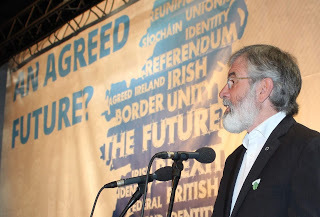 The issue of Irish unity is now a matter of almost daily conversation. Despite the negativity of both governments there is growing support for a referendum on unity and for a united Ireland.
The issue of Irish unity is now a matter of almost daily conversation. Despite the negativity of both governments there is growing support for a referendum on unity and for a united Ireland. But there is much work to be done. Republicans have a responsibility to map out the kind of shared new Ireland, we are working to build. A key element of any strategy of persuasion requires republicans address the issues of affordability and prosperity.Of course, there will be some unionists who will remain opposed to unity on ideological, cultural, or historical grounds. Or for emotional reasons. Some may also have fears about the future. But there are others who are open to persuasion that unity makes sense in the context of Brexit. These voices were heard in the recent Féile debates. These citizens believe in the equal provision of rights for every citizen. And they are open to positive arguments around economic growth and greater prosperity.There are also some nationalists, north and south, who also aspire to unity but are nervous, uncertain, and who similarly need to be persuaded. The issue of rights and the EU will be important for them, but so too is the question of affordability and prosperity.The claim is regularly made that the north’s economy is entirely reliant on ten billion pounds of a subvention that comes from the block grant from Britain. In a united Ireland it is claimed that Dublin would have to find this money and that as a result public services would suffer from cutbacks. This is not true.The reality is that since partition decisions taken around the management, investment and development of the north’s economy were the responsibility of the Ulster Unionist government at Stormont up to 1972 and subsequently by British governments. Even under the Executive almost all of the key economic levers – taxation, welfare, immigration and more – were and are directly controlled by Westminster.British Treasury Figures relating to the north and to the block grant are deliberately misleading and are purposely used as a source of misinformation to defend the union with Britain. The British Government claims that it allocated 24bn (billion) of public spending to the north for the year 2015-16. This figure is used by political unionism and others to argue that there is a £10bn deficit.Of this 24bn figure 3.7bn is spent on British defence, overseas representation, and debt. This spending does not relate to the north. It is a matter for the British state and is not our debt. That leaves 20.3bn.The British Government estimates revenue generated within the north at 16.7bn. That means that the gap between what is spent and what is raised in the north is closer to 3.6 bn.In addition British Government Departments claim that they spend 1.8bn of this on the north. Aspects of this spending may or may not be considered to be essential. It is Sinn Féin’s position that this spend cannot fully be considered to be local debt until it is devolved to local budgets.Therefore the local spending deficit - which is the difference between the amount of money spent and raised in the north by the Executive and local authorities - is £1.8bn. To summarise, based on official British Treasury information the fiscal deficit in the north is at most in the range of £1.8bn to £3.6bn.In the context of Irish unity, in which the entire island is part of the EU, where the additional costs relating to the duplication of services are ended and with Irish control of our economic strategies, investment and growth, it is clear that Irish unity makes economic sense and is affordable.
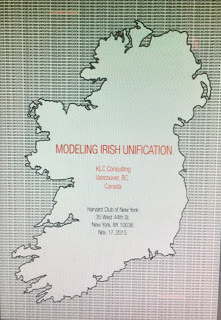 Support for this is contained in peer reviewed paper published in November 2015 by Professor Kurt Huebner of Vancouver University which is titled ‘
Modeling Irish Unification
’. It concluded that Irish unity would likely result in a sizable boost in economic outcomes and incomes north and South, with the most aggressive unification scenario estimating a boost in all island GDP of €35.6 billion Euro over eight years. That’s an increase in each of those years of €5,500 per person north and south.More recently in July a report researched by Gunther Thurmann, who worked in the German Desk for the International Monetary Fund (IMF) during German reunification, along with Senator Mark Daly of the Oireachtas Good Friday Implementation Committee, entitled 'Northern Ireland's Income and Expenditure in a Reunification scenario' concluded that the north would cease to be a financial dependency in the event of a united Ireland. It said that the six counties would save £8.5bn a year by leaving the British state and uniting with the rest of the island. This would bring the North close to a balanced budget.
Support for this is contained in peer reviewed paper published in November 2015 by Professor Kurt Huebner of Vancouver University which is titled ‘
Modeling Irish Unification
’. It concluded that Irish unity would likely result in a sizable boost in economic outcomes and incomes north and South, with the most aggressive unification scenario estimating a boost in all island GDP of €35.6 billion Euro over eight years. That’s an increase in each of those years of €5,500 per person north and south.More recently in July a report researched by Gunther Thurmann, who worked in the German Desk for the International Monetary Fund (IMF) during German reunification, along with Senator Mark Daly of the Oireachtas Good Friday Implementation Committee, entitled 'Northern Ireland's Income and Expenditure in a Reunification scenario' concluded that the north would cease to be a financial dependency in the event of a united Ireland. It said that the six counties would save £8.5bn a year by leaving the British state and uniting with the rest of the island. This would bring the North close to a balanced budget.
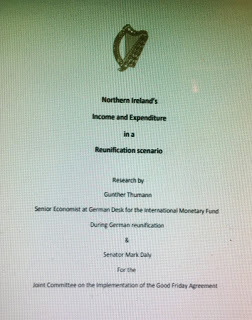 So, it’s all to play for. Achieving a referendum on Irish unity is no longer a matter of if but when. Winning that referendum and creating a new, shared Ireland inclusive of every citizen who lives on this island is similarly no longer a matter of if but when. Our task as united Irelanders is to achieve these objectives in the shortest possible time with the maximum level of popular support. That means planning for a referendum and planning for unity. Now isn’t that a challenge worth working to achieve?
So, it’s all to play for. Achieving a referendum on Irish unity is no longer a matter of if but when. Winning that referendum and creating a new, shared Ireland inclusive of every citizen who lives on this island is similarly no longer a matter of if but when. Our task as united Irelanders is to achieve these objectives in the shortest possible time with the maximum level of popular support. That means planning for a referendum and planning for unity. Now isn’t that a challenge worth working to achieve?
Published on August 29, 2018 16:40
August 23, 2018
I LOVE HURLING.
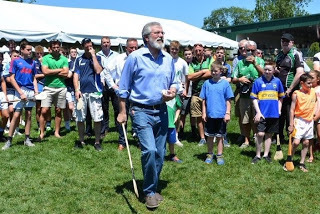
I love hurling. The beauty of it. The skill. The magic. The rootedness. The Irishness of it. Even as a little boy on my own hitting a sliotar off a gable wall. I loved that. Up and back. Up and back. Pull on it. Sliotar up on the bos of the hurl. It’s all in the wrists. Flick the sliotar up. Pull on it. Catch it coming back. Pull on it again. Or better still catch it on the hurl and blarge it off the wall again without touching it with your hand. It’s all in the stick work.
Pull on the ground. First touch. Two hands on the hurl. Pull again. Don’t hesitate. Sliotar finding the bos of the hurl. Pull on it. Keep your eye on the ball! Don’t hesitate. Pull first time. Mighty! Pull again.
Brother Aloysius told us that the hurley should be an extension of our arms. Keep the hurl with you at all times boys he told us. Practice. Practice. Practice. Hurling is part of us. We have played it for centuries. The fastest field game in the world. Keep your eye on the ball. Pull on it. The sweet thunk sound of the ash stick hitting the leather sliotar and the reassuring vibration up your arm when you puck the sliothar the way it deserves.
Always keep your eye on the sliotar. Keep your hurl up. Don’t stand off your man. Mark him. How many times do I have to tell you that? Get in tight to him. Don’t stand back. Use your shoulder. What are you afraid of? Give him a dunt. Hurl up. Hook him. That’s your ball. Do you not want it? Hurl up! What a mighty block! That’s great hurling wee buck! Now don’t make a mess of it. That’s it. Get rid of it. Drive it up the field.
Pull on it on the ground. Is there a hole in your hurley? Pull on it first time. Pull on it! Pass it. Get rid of it. Does anyone want the ball? Show for it. Don’t leave him on his own. Get tore in lads. Help him. Clear your lines. Let the sliotar do the running. Good job lads. Well done.
It’s all in the wrists. Hold your hurl at arms length. Make a figure eight on its side. Again and again and again. Get the stick work right. Build your skills. The camán isn’t a sledge hammer. It’s a wand. It only needs a wee touch. A flick. It’s all in the wrists.
Hit the ball. Get rid of it. Don't take the sliotar into your hand. Hit it off your hurl. Practice! Practice! Practice! I love a Saturday or Sunday morning watching young camógs or their wee male club mates learning their hurling skills from older mentors.
That skill which in time will empower a decent hurler or a camóg to strike a sliotar while running at speed so that it finds a team mate sixty yards away across the playing field. Imagine? How do they do it? How does a side line cut happen? How do high fielders pluck a sliothar from the sky from within a forest of hurls? How do they notch up points from the most impossible angles? Or from their own half of the field? Practice!
How do goalkeepers prevent certain goals? How do they snatch or block or catch sliotars fired at them like cannon balls? What would we be without hurling? What would we do? Where would we be? It’s part of what we are. We have been doing it for thousands of years. Practice! Keep your eye on the ball. Both hands on the hurl. Practice.
That’s how Limerick won the All Ireland. Belief! A young lad pucking a ball of a gable wall. On his own. Emulating his heroes. Playing for his county. A camóg! Rising to the challenge. Being herself. Pulling on the ball. The sweet thunk sound when she hits the sliotar the way it deserves. The satisfying vibration of the ash stick up your wrist as it strikes the sliotar exactly right. That’s how it starts. Belief.
That’s what wins. We did it when those who ruled us declared it to be illegal. When carrying a hurling stick, a camán, was deemed by them to be an offence. We refused to stop. And we got better at not stopping. We kept going. Sliotar up on the hurl. Run like a deer. Puck it forward. Rise like a salmon for a high ball. Do your best. Get there first. Block. Hook. Puck. Pull on it.
Or watch and encourage others doing it. When we’re not able to hurl does that mean we can’t enable others? To keep it going. To do it better. To give them the means. The supports. The resources. The example. To play for our club. Our county. To be the All Ireland Champions of the world. Believe. That’s what has kept us going for thousands of years. It’s part of what we are. That’s hurling. As old as Ireland. And as young as tomorrow.
I love wee lads and wee girls getting used to their first hurl. Only four or five years old. Doing what we have been doing for thousands of years. Just starting. That’s what it is about. Always starting. No matter what. Decades after we were prohibited from hurling. I love that. The beauty of it. The skill. The magic. Young ones showing us how to hurl. Doing it all again. Doing it better. Keeping it going.
Or an oul lad pucking a sliotar for his dog to chase and retrieve. I love that. Especially on a sea shore. Pucking the sliothar at the sea. Aiming to hit Balor on his one good eye. Soaring ithe sliotar above the tide. The dog charging into the waves. His head bobbing above the water. The sliotar beyond his reach. But he finds it. Then back to shore to drop it at my feet for me and him to do it all over again. We have been doing it for thousands of years. Emulating our heroes. Cú Chullan lives. And we get better at it every year we do it. Well done Galway. Comhghairdeas Limerick. C’mon Antrim.
I love hurling.
Published on August 23, 2018 05:45
August 16, 2018
Sisters taking a stand.
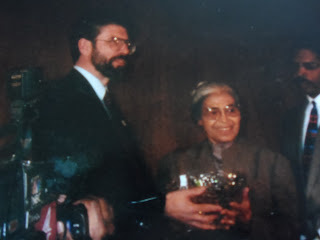 Mise agus Rosa Parks
This Saturday there will a march from Coalisland to Dungannon to mark the 50th anniversary of the first ever civil rights march in the north. It was a pivotal moment in the struggle against the injustice, bigotry and discrimination of the Unionist regime at Stormont.For the Unionist regime its gerrymandered electoral system involved building very few houses for Catholic families, even if their need was greater; even if their home was designated as unfit for human habitation. As a result tens of thousands of citizens were denied the right to vote for local councillors.In a report published in 1936 the National Council of Civil Liberties condemned the use by the Stormont Regime of the Special Powers Act. In its report it tersely and effectively described the northern state. Unionists it said had created ‘under the shadow of the British constitution a permanent machine of dictatorship.’In protest at this system, and against the discrimination in housing the Gildernew family took a stand. In October 1967, led by Fermanagh/S Tyrone MP Michelle Gildernew’s granny, Nana, they squatted in a house in Kinnard Park in Caledon in south Tyrone. The local Council in Dungannon had a deserved reputation for discrimination against Catholics in housing and had allocated the house – over 269 other applicants on the waiting list - to a single 19-year-old woman who was employed by a prospective unionist candidate. Local republicans, including Francie Molly and Stan Corrigan, and Stormont Nationalist MP Austin Currie backed the Gildernews.
Mise agus Rosa Parks
This Saturday there will a march from Coalisland to Dungannon to mark the 50th anniversary of the first ever civil rights march in the north. It was a pivotal moment in the struggle against the injustice, bigotry and discrimination of the Unionist regime at Stormont.For the Unionist regime its gerrymandered electoral system involved building very few houses for Catholic families, even if their need was greater; even if their home was designated as unfit for human habitation. As a result tens of thousands of citizens were denied the right to vote for local councillors.In a report published in 1936 the National Council of Civil Liberties condemned the use by the Stormont Regime of the Special Powers Act. In its report it tersely and effectively described the northern state. Unionists it said had created ‘under the shadow of the British constitution a permanent machine of dictatorship.’In protest at this system, and against the discrimination in housing the Gildernew family took a stand. In October 1967, led by Fermanagh/S Tyrone MP Michelle Gildernew’s granny, Nana, they squatted in a house in Kinnard Park in Caledon in south Tyrone. The local Council in Dungannon had a deserved reputation for discrimination against Catholics in housing and had allocated the house – over 269 other applicants on the waiting list - to a single 19-year-old woman who was employed by a prospective unionist candidate. Local republicans, including Francie Molly and Stan Corrigan, and Stormont Nationalist MP Austin Currie backed the Gildernews.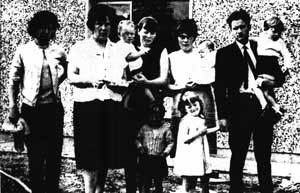 T
he Gildernew family after their eviction from the house in Caledon
On June 18th 1968 bailiffs, and RUC men, forced their way into the home and the family were evicted. There was widespread anger at this. The Civil Rights Association, which had been founded the previous year, had as one of its demands an end to discrimination in housing. Looking to the example of the Civil Rights campaign in the USA it decided to organise a peaceful march to highlight the issue. The Coalisland to Dungannon march was the result.Nana Gildernew wasn’t the first woman to take a stand against injustice. There have been countless others in Ireland and many more in similar struggles for freedom across the world. I have a particular affection and admiration for Mary Ann McCracken. And Alice Milligan, Elizabeth O Farrell and Winfred Carney from our own place and others from across the world like Harriet Tubman. In 1994 on one of my first visits to the USA I had the honour to meet one of my heroes – Rosa Parks. In December 1955 Rosa Parks, who was a seamstress, boarded a bus in Montgomery, Alabama. The bus driver ordered her to leave her seat in the ‘coloured section’ of the bus for boarding white passengers. Rosa Parks refused. She refused to go to the back of the bus. As a result she was arrested for violating the segregation laws in Alabama.There were subsequent claims that she had been ‘planted’ by the civil rights movement to create a controversy. Martin Luther King, in his book ‘Stride Toward Freedom’ described it well. He wrote: “No one can understand the action of Mrs. Parks unless he realises that eventually the cup of endurance runs over, and the human personality cries out, ‘I can take it no longer.’ Mrs. Parks’ refusal to move back was her intrepid affirmation that she had had enough. It was an individual expression of a timeless longing for human dignity and self-respect.”At the end of July another woman who had had enough, seventeen year old Palestinian teenager Ahed Tamimi, was released after spending eight months in an Israeli prison for slapping two Israeli soldiers. Her courage and fearlessness in the face of armed aggression by Israeli soldiers caught the imagination of many people internationally. Her release was widely reported as was her call for greater support for the people of Palestine in their struggle for self-determination. Ahed is only one of a new generation of Palestinians standing up for their right to be free from oppression.
T
he Gildernew family after their eviction from the house in Caledon
On June 18th 1968 bailiffs, and RUC men, forced their way into the home and the family were evicted. There was widespread anger at this. The Civil Rights Association, which had been founded the previous year, had as one of its demands an end to discrimination in housing. Looking to the example of the Civil Rights campaign in the USA it decided to organise a peaceful march to highlight the issue. The Coalisland to Dungannon march was the result.Nana Gildernew wasn’t the first woman to take a stand against injustice. There have been countless others in Ireland and many more in similar struggles for freedom across the world. I have a particular affection and admiration for Mary Ann McCracken. And Alice Milligan, Elizabeth O Farrell and Winfred Carney from our own place and others from across the world like Harriet Tubman. In 1994 on one of my first visits to the USA I had the honour to meet one of my heroes – Rosa Parks. In December 1955 Rosa Parks, who was a seamstress, boarded a bus in Montgomery, Alabama. The bus driver ordered her to leave her seat in the ‘coloured section’ of the bus for boarding white passengers. Rosa Parks refused. She refused to go to the back of the bus. As a result she was arrested for violating the segregation laws in Alabama.There were subsequent claims that she had been ‘planted’ by the civil rights movement to create a controversy. Martin Luther King, in his book ‘Stride Toward Freedom’ described it well. He wrote: “No one can understand the action of Mrs. Parks unless he realises that eventually the cup of endurance runs over, and the human personality cries out, ‘I can take it no longer.’ Mrs. Parks’ refusal to move back was her intrepid affirmation that she had had enough. It was an individual expression of a timeless longing for human dignity and self-respect.”At the end of July another woman who had had enough, seventeen year old Palestinian teenager Ahed Tamimi, was released after spending eight months in an Israeli prison for slapping two Israeli soldiers. Her courage and fearlessness in the face of armed aggression by Israeli soldiers caught the imagination of many people internationally. Her release was widely reported as was her call for greater support for the people of Palestine in their struggle for self-determination. Ahed is only one of a new generation of Palestinians standing up for their right to be free from oppression.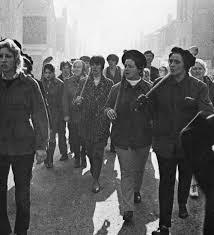 Marie Moore and Maire Drumm leading by example
And so it was with in Ireland in the 60’s and since. Women like Nana Gildernew and Betty Sinclair, Patricia McCluskey, Brigid Bond, Madge Davison, Bernadette McAliskey and others from that time and later. Women like Maire Drumm and Marie Moore, who helped break the British Army curfew of the Lower Falls in 1970. Women like Sheena Campbell and Mairead Farrell and many more who had had enough and dared to challenge the political sectarianism and the armed forces of the British state.
Marie Moore and Maire Drumm leading by example
And so it was with in Ireland in the 60’s and since. Women like Nana Gildernew and Betty Sinclair, Patricia McCluskey, Brigid Bond, Madge Davison, Bernadette McAliskey and others from that time and later. Women like Maire Drumm and Marie Moore, who helped break the British Army curfew of the Lower Falls in 1970. Women like Sheena Campbell and Mairead Farrell and many more who had had enough and dared to challenge the political sectarianism and the armed forces of the British state.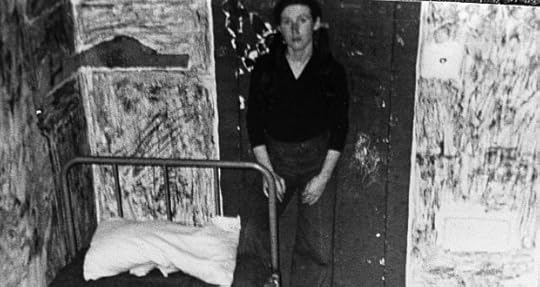 Mairead Farrell on protest in Armagh Women's Prison
In the struggle for freedom and justice, wherever that struggle has occurred, whether in Ireland or South Africa or the West Bank and the Gaza Strip, or in countless other places around the world, women have always played a substantial and leadership role. It has not always been recognised and acknowledged. These unmanageable revolutionaries have risked life, and injury and imprisonment in their determination to take a stand and to improve the quality of life of their families and neighbours and communities.Details: The march from Coalisland to Dungannon, will begin at 3pm on Saturday 18th August, in the square in Coalisland.
Mairead Farrell on protest in Armagh Women's Prison
In the struggle for freedom and justice, wherever that struggle has occurred, whether in Ireland or South Africa or the West Bank and the Gaza Strip, or in countless other places around the world, women have always played a substantial and leadership role. It has not always been recognised and acknowledged. These unmanageable revolutionaries have risked life, and injury and imprisonment in their determination to take a stand and to improve the quality of life of their families and neighbours and communities.Details: The march from Coalisland to Dungannon, will begin at 3pm on Saturday 18th August, in the square in Coalisland.
Published on August 16, 2018 16:44
August 11, 2018
Go raibh maith agat Mr. Ballagh
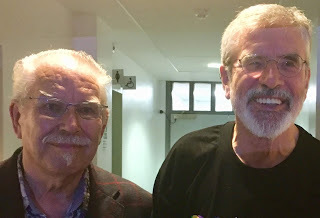 Bobby Ballagh agus mise
Féile on Phobail is celebrating its 30th birthday this year. In the three decades since its establishment a lot has changed, not least the growth of the Féile. It’s now the biggest community festival on these islands. One example of that growth is the amazing number of visual art exhibitions. This year there are almost 50 exhibitions with hundreds of images.Last Thursday evening renowned Irish artist Robert Ballagh, who has been a regular contributor to Féile, came to St. Mary’s University College on the Falls Road to formally open the exhibition. It was a marvellous evening.I was asked to say a few words of thanks to mark Bobby’s long association with Féile. I was very happy to do so. It’s really important in the busyness of all of our lives that we take time to thank people. And I’m especially talking about people, who take a stand when they don’t necessarily need to. People who continue to make a stand. People who have remained faithful. Robert Ballagh is one of the great stalwarts of progressive politics and the struggle for peace in Ireland and internationally. When we founded Féile it was to celebrate and to showcase the creativity of this community, of the people of west Belfast.It was also to provide a platform for others from outside of west Belfast to join us, to use their creative genius in solidarity with us, to uplift us and to encourage us. And they came. Musicians, writers, poets, actors, actresses, playwrights, film makers, camogs, hurlers, dancers, chancers, fly men and wise women.They all came and Robert Ballagh was there also. He is one of our island’s greatest visual artists. He’s passionate about his work but he’s also very passionate in the help and support he gives to others. He was there with the Birmingham 6 and the Guildford 4, with the families of Bloody Sunday, with the victims of the Dublin Monaghan bombings, with Pat Finucane’s family, with the people of Palestine, with the anti-apartheid movement. He is there with all of the other little causes when somebody says ‘will you go and get Bobby to do a print, will you get Bobby to do a painting, will you get Bobby to do something’ and Bobby Ballagh has always delivered.He established with others the Ireland Institute for Historical and Cultural Studies on Pearse Street in Dublin. It is the birthplace of Padraig MacPiaris. The historical significance of the building was being ignored by Irish governments and it needed citizens to develop it. There would be nothing to mark where Pearse was born but for their efforts. The same thing happened with Kilmainham Prison which successive governments failed to protect properly or to develop its potential.Robert was the chair of the Irish National Congress which campaigned for unity and for justice. He has designed over 70 stamps for An Post. So most of us will have had some of his work in our hands at some time in our lives. He designed the last batch of punt bank notes which featured James Joyce, Daniel O’Connell, Douglas Hyde and Charles Stewart Parnell. And he also created and designed the set for Riverdance. Robert has also been responsible for the sets of many Sinn Féin Ard Fheiseanna. Apart from exhibiting his own work at Féile he helped some of our fledgling school of mural painters back in the day. In 1988 Bobby came to west Belfast to judge our murals. It was our first Féile and there was a group of young mural artists, who were being helped by Danny Devenny, Marty and Mo Chara. We asked them what they wanted to paint for Bobby to judge and they chose to paint a mural of Nelson Mandela. It was Madiba’s 70th birthday and 25th year in prison. Under the banner ‘Father of Freedom; the future belongs to you,’ they painted ‘Happy Birthday Comrade’ on a gable house at the corner of Leeson Street and the Falls Road.Bobby has been back here year after year after year. Two years ago we had a very big celebration to mark the centenary of the 1916 Easter Rising. But it isn’t that long since Irish governments didn’t commemorate 1916. In fact, not only did they not celebrate 1916 but they banned others from commemorating it.In one famous instance in 1976 Nora Connolly O’Brien, the daughter of James Connolly, was arrested for taking part in a commemoration outside the GPO.In 1991 Bobby and a group of concerned citizens - aware that the Irish government was determined to ignore the 75 anniversary of the Easter Rising - organised a ‘Reclaim the Spirit of Easter’ commemoration. It was a brave step to take.That was a great initiative and it wouldn’t have happened without Robert Ballagh and without the creative and colourful way in which those men and women were celebrated. I was there. It was a great day of music and craic and drama.Two years ago Sinn Féin organised our own programme of events as part of the ‘Reclaim the Vision of Easter 1916’. We worked closely with Bobby as he, and his broad alliance of activists, organised a series of events, including a national march which took place on the date of the Rising, April 24th 1916.So, on this the 30th anniversary of the Féile an Phobail I am delighted to say thank you to my friend Mr. Ballagh for all of that activism. Thank you especially for your art. Art, culture, the work of the imagination, should be applauded for its own sake. Because it moves us. It makes us think. It makes us marvel. It gives us pleasure. It can empower us. It takes us out of our of ourselves. That’s whether we are the artist or we are the person enjoying the piece of art. And all of that is very, very important. It seems to me that the imagination is probably what the soul is – it is the essence of our spirit. To live in our imagination and to move people by the use of our imagination, by artistic expression is a very fine and joyous experience. But art that stands up for itself, that highlights injustice, as well as being art of the highest quality, it what Robert Ballagh does and by so doing he leads the way for others who don’t. And Bobby Sands had a word for them.‘The men of art have sold their heart They dream within their dreamTheir magic soul for price of goldAmidst a peoples screams’Robert Ballagh never sold his magic for the price of gold. He used it to empower and enrich us all. Long may you keep doing so. Míle buiochas Bobby.
Bobby Ballagh agus mise
Féile on Phobail is celebrating its 30th birthday this year. In the three decades since its establishment a lot has changed, not least the growth of the Féile. It’s now the biggest community festival on these islands. One example of that growth is the amazing number of visual art exhibitions. This year there are almost 50 exhibitions with hundreds of images.Last Thursday evening renowned Irish artist Robert Ballagh, who has been a regular contributor to Féile, came to St. Mary’s University College on the Falls Road to formally open the exhibition. It was a marvellous evening.I was asked to say a few words of thanks to mark Bobby’s long association with Féile. I was very happy to do so. It’s really important in the busyness of all of our lives that we take time to thank people. And I’m especially talking about people, who take a stand when they don’t necessarily need to. People who continue to make a stand. People who have remained faithful. Robert Ballagh is one of the great stalwarts of progressive politics and the struggle for peace in Ireland and internationally. When we founded Féile it was to celebrate and to showcase the creativity of this community, of the people of west Belfast.It was also to provide a platform for others from outside of west Belfast to join us, to use their creative genius in solidarity with us, to uplift us and to encourage us. And they came. Musicians, writers, poets, actors, actresses, playwrights, film makers, camogs, hurlers, dancers, chancers, fly men and wise women.They all came and Robert Ballagh was there also. He is one of our island’s greatest visual artists. He’s passionate about his work but he’s also very passionate in the help and support he gives to others. He was there with the Birmingham 6 and the Guildford 4, with the families of Bloody Sunday, with the victims of the Dublin Monaghan bombings, with Pat Finucane’s family, with the people of Palestine, with the anti-apartheid movement. He is there with all of the other little causes when somebody says ‘will you go and get Bobby to do a print, will you get Bobby to do a painting, will you get Bobby to do something’ and Bobby Ballagh has always delivered.He established with others the Ireland Institute for Historical and Cultural Studies on Pearse Street in Dublin. It is the birthplace of Padraig MacPiaris. The historical significance of the building was being ignored by Irish governments and it needed citizens to develop it. There would be nothing to mark where Pearse was born but for their efforts. The same thing happened with Kilmainham Prison which successive governments failed to protect properly or to develop its potential.Robert was the chair of the Irish National Congress which campaigned for unity and for justice. He has designed over 70 stamps for An Post. So most of us will have had some of his work in our hands at some time in our lives. He designed the last batch of punt bank notes which featured James Joyce, Daniel O’Connell, Douglas Hyde and Charles Stewart Parnell. And he also created and designed the set for Riverdance. Robert has also been responsible for the sets of many Sinn Féin Ard Fheiseanna. Apart from exhibiting his own work at Féile he helped some of our fledgling school of mural painters back in the day. In 1988 Bobby came to west Belfast to judge our murals. It was our first Féile and there was a group of young mural artists, who were being helped by Danny Devenny, Marty and Mo Chara. We asked them what they wanted to paint for Bobby to judge and they chose to paint a mural of Nelson Mandela. It was Madiba’s 70th birthday and 25th year in prison. Under the banner ‘Father of Freedom; the future belongs to you,’ they painted ‘Happy Birthday Comrade’ on a gable house at the corner of Leeson Street and the Falls Road.Bobby has been back here year after year after year. Two years ago we had a very big celebration to mark the centenary of the 1916 Easter Rising. But it isn’t that long since Irish governments didn’t commemorate 1916. In fact, not only did they not celebrate 1916 but they banned others from commemorating it.In one famous instance in 1976 Nora Connolly O’Brien, the daughter of James Connolly, was arrested for taking part in a commemoration outside the GPO.In 1991 Bobby and a group of concerned citizens - aware that the Irish government was determined to ignore the 75 anniversary of the Easter Rising - organised a ‘Reclaim the Spirit of Easter’ commemoration. It was a brave step to take.That was a great initiative and it wouldn’t have happened without Robert Ballagh and without the creative and colourful way in which those men and women were celebrated. I was there. It was a great day of music and craic and drama.Two years ago Sinn Féin organised our own programme of events as part of the ‘Reclaim the Vision of Easter 1916’. We worked closely with Bobby as he, and his broad alliance of activists, organised a series of events, including a national march which took place on the date of the Rising, April 24th 1916.So, on this the 30th anniversary of the Féile an Phobail I am delighted to say thank you to my friend Mr. Ballagh for all of that activism. Thank you especially for your art. Art, culture, the work of the imagination, should be applauded for its own sake. Because it moves us. It makes us think. It makes us marvel. It gives us pleasure. It can empower us. It takes us out of our of ourselves. That’s whether we are the artist or we are the person enjoying the piece of art. And all of that is very, very important. It seems to me that the imagination is probably what the soul is – it is the essence of our spirit. To live in our imagination and to move people by the use of our imagination, by artistic expression is a very fine and joyous experience. But art that stands up for itself, that highlights injustice, as well as being art of the highest quality, it what Robert Ballagh does and by so doing he leads the way for others who don’t. And Bobby Sands had a word for them.‘The men of art have sold their heart They dream within their dreamTheir magic soul for price of goldAmidst a peoples screams’Robert Ballagh never sold his magic for the price of gold. He used it to empower and enrich us all. Long may you keep doing so. Míle buiochas Bobby.
Published on August 11, 2018 07:15
Gerry Adams's Blog
- Gerry Adams's profile
- 29 followers
Gerry Adams isn't a Goodreads Author
(yet),
but they
do have a blog,
so here are some recent posts imported from
their feed.



